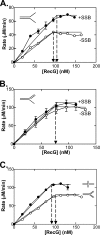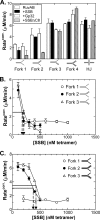Characterization of the ATPase activity of RecG and RuvAB proteins on model fork structures reveals insight into stalled DNA replication fork repair
- PMID: 23893472
- PMCID: PMC3772186
- DOI: 10.1074/jbc.M113.500223
Characterization of the ATPase activity of RecG and RuvAB proteins on model fork structures reveals insight into stalled DNA replication fork repair
Abstract
RecG and RuvAB are proposed to act at stalled DNA replication forks to facilitate replication restart. To clarify the roles of these proteins in fork regression, we used a coupled spectrophotometric ATPase assay to determine how these helicases act on two groups of model fork substrates: the first group mimics nascent stalled forks, whereas the second mimics regressed fork structures. The results show that RecG is active on the substrates in group 1, whereas these are poor substrates for RuvAB. In addition, in the presence of group 1 forks, the single-stranded DNA-binding protein (SSB) enhances the activity of RecG and enables it to compete with excess RuvA. In contrast, SSB inhibits the activity of RuvAB on these substrates. Results also show that the preferred regressed fork substrate for RuvAB is a Holliday junction, not a forked DNA. The active form of the enzyme on the Holliday junction contains a single RuvA tetramer. In contrast, although the enzyme is active on a regressed fork structure, RuvB loading by a single RuvA tetramer is impaired, and full activity requires the cooperative binding of two forked DNA substrate molecules. Collectively, the data support a model where RecG is responsible for stalled DNA replication fork regression. SSB ensures that if the nascent fork has single-stranded DNA character RuvAB is inhibited, whereas the activity of RecG is preferentially enhanced. Only once the fork has been regressed and the DNA is relaxed can RuvAB bind to a RecG-extruded Holliday junction.
Keywords: ATPases; DNA Recombination; DNA-Protein Interaction; DNA-binding Protein; Enzyme Kinetics; Fork Regression; Holliday Junction; RecG; Replication Fork; RuvAB.
Figures







Similar articles
-
RecG interacts directly with SSB: implications for stalled replication fork regression.Nucleic Acids Res. 2008 Dec;36(22):7029-42. doi: 10.1093/nar/gkn795. Epub 2008 Nov 5. Nucleic Acids Res. 2008. PMID: 18986999 Free PMC article.
-
Regression of replication forks stalled by leading-strand template damage: I. Both RecG and RuvAB catalyze regression, but RuvC cleaves the holliday junctions formed by RecG preferentially.J Biol Chem. 2014 Oct 10;289(41):28376-87. doi: 10.1074/jbc.M114.587881. Epub 2014 Aug 19. J Biol Chem. 2014. PMID: 25138216 Free PMC article.
-
Formation of a stable RuvA protein double tetramer is required for efficient branch migration in vitro and for replication fork reversal in vivo.J Biol Chem. 2011 Jun 24;286(25):22372-83. doi: 10.1074/jbc.M111.233908. Epub 2011 Apr 29. J Biol Chem. 2011. PMID: 21531731 Free PMC article.
-
DNA Helicase-SSB Interactions Critical to the Regression and Restart of Stalled DNA Replication forks in Escherichia coli.Genes (Basel). 2020 Apr 26;11(5):471. doi: 10.3390/genes11050471. Genes (Basel). 2020. PMID: 32357475 Free PMC article. Review.
-
I came to a fork in the DNA and there was RecG.Prog Biophys Mol Biol. 2015 Mar;117(2-3):166-173. doi: 10.1016/j.pbiomolbio.2015.01.001. Epub 2015 Jan 20. Prog Biophys Mol Biol. 2015. PMID: 25613916 Free PMC article. Review.
Cited by
-
Nanoscale interaction of RecG with mobile fork DNA.Nanoscale Adv. 2020 Mar 1;2(3):1318-1324. doi: 10.1039/c9na00712a. Epub 2020 Feb 11. Nanoscale Adv. 2020. PMID: 33791509 Free PMC article.
-
High-affinity DNA-binding domains of replication protein A (RPA) direct SMARCAL1-dependent replication fork remodeling.J Biol Chem. 2015 Feb 13;290(7):4110-7. doi: 10.1074/jbc.M114.627083. Epub 2014 Dec 31. J Biol Chem. 2015. PMID: 25552480 Free PMC article.
-
Single-molecule insight into stalled replication fork rescue in Escherichia coli.Nucleic Acids Res. 2021 May 7;49(8):4220-4238. doi: 10.1093/nar/gkab142. Nucleic Acids Res. 2021. PMID: 33744948 Free PMC article. Review.
-
Irc3 is a mitochondrial DNA branch migration enzyme.Sci Rep. 2016 May 19;6:26414. doi: 10.1038/srep26414. Sci Rep. 2016. PMID: 27194389 Free PMC article.
-
Viral and cellular SOS-regulated motor proteins: dsDNA translocation mechanisms with divergent functions.Cell Biosci. 2014 Jun 25;4:31. doi: 10.1186/2045-3701-4-31. eCollection 2014. Cell Biosci. 2014. PMID: 24995125 Free PMC article. Review.
References
-
- Kowalczykowski S. C. (2000) Initiation of genetic recombination and recombination-dependent replication. Trends Biochem. Sci. 25, 156–165 - PubMed
-
- Seigneur M., Bidnenko V., Ehrlich S. D., Michel B. (1998) RuvAB acts at arrested replication forks. Cell 95, 419–430 - PubMed
-
- Cox M. M., Goodman M. F., Kreuzer K. N., Sherratt D. J., Sandler S. J., Marians K. J. (2000) The importance of repairing stalled replication forks. Nature 404, 37–41 - PubMed
Publication types
MeSH terms
Substances
Grants and funding
LinkOut - more resources
Full Text Sources
Other Literature Sources
Molecular Biology Databases

